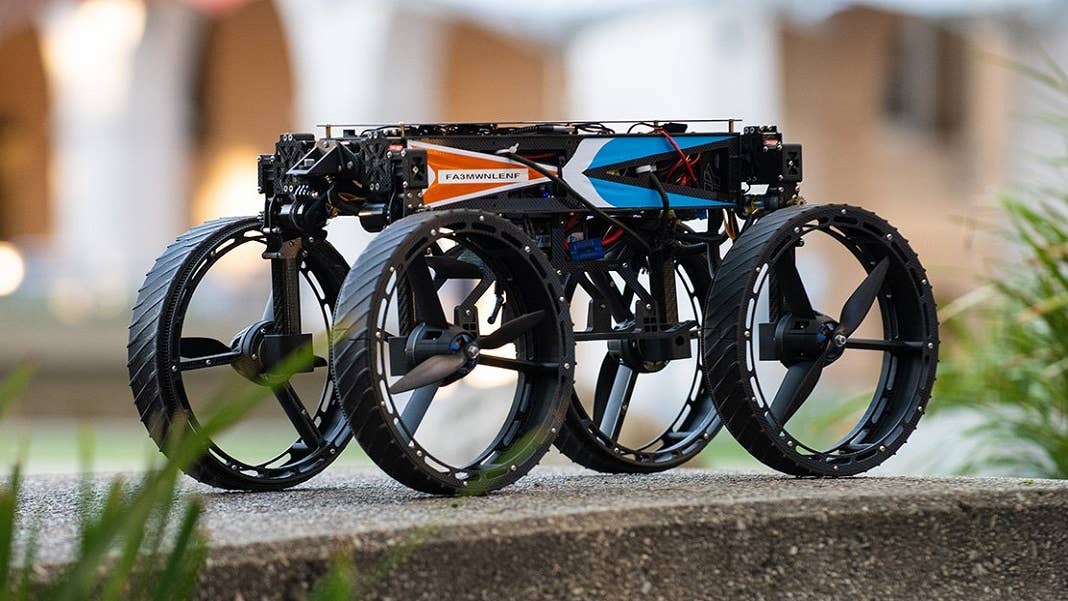This Transformer-Like Robot Can Drive, Fly, Walk, and More

Share
Robots are slowly getting smarter, mostly thanks to advances in artificial intelligence that enable them to learn on their own rather than requiring constant human guidance. But despite being able to independently learn new tasks, most robots are still limited to a single form of motion—that is, they either walk, crawl, swim, fly, or move within a given area. A new robot designed by researchers at Caltech's Center for Autonomous Systems and Technologies (CAST) can do it all, though.
Called M4, which is short for Multi-Modal Mobility Morphobot, the robot can roll on four wheels, turn its wheels into rotors and fly, stand on two wheels to see over obstacles, use its wheels like feet to walk, use two rotors to add momentum while it rolls up inclines on two wheels, tumble, and more. In a paper published this week in Nature Communications, the robot’s creators explain that their inspiration came from various animals.
Chukars, a type of partridge found in the western US, can run uphill with the help of their wings, flapping them to create momentum and make the climb easier. Meerkats can walk on all fours or rise up on their two hind legs to get a better view of whatever’s in front of them. Sea lions can use their flippers to move in different ways in water and on land. And so on.
M4 looks like a sort of flat, rectangular car with four large wheels. Except each of the wheels has a propeller in it, and they can double as legs or thrusters. If the bot wants to stand on two wheels, the other two fold up and their propellers start spinning to add balance. If the bot wants to fly, all four of the wheels fold up and the propellers lift the robot off the ground, like a drone. The wheel assemblies are also equipped with joints that enable the bot to walk, though its creators say this capability needs to be further refined.
“Our aim was to push the boundaries of robot locomotion by designing a system that showcases extraordinary mobility capabilities with a wide range of distinct locomotion modes. The M4 project successfully achieved these objectives,” Alireza Ramezani, a corresponding author of the paper, said in a press release.
Be Part of the Future
Sign up to receive top stories about groundbreaking technologies and visionary thinkers from SingularityHub.


Using AI, the M4 robot can perceive its environment and decide which form of motion to employ for navigating it—then, like the Transformers you may have seen in cartoons as a kid (or in the movie released earlier this month), M4 morphs into whatever shape needed to move forward. For example, it could go from rolling across a flat surface on its four wheels to pausing and standing on its rear wheels to see over an obstacle. If that obstacle revealed water or another terrain it couldn’t cross on wheels, it could switch its wheels into rotor mode and fly.
There are already search and rescue robots that aim to search disaster sites to help find and recover people or objects. M4 could serve a similar role, with its ability to navigate complex terrain coming in especially handy. Its creators say it could even be used to explore other planets, like a Mars rover with even more abilities. The research was funded by NASA’s Jet Propulsion Laboratory and the National Science Foundation, so both institutions must see useful applications of robots like M4.
Mory Gharib, CAST’s director and the paper’s co-author, emphasized the importance of AI in the robot’s functioning. “When encountering unknown environments, only robots that have the ability to repurpose their multi-modal components aided by artificial intelligence can succeed,” he said.
Image Credit: Caltech Center for Autonomous Systems and Technologies
Vanessa has been writing about science and technology for eight years and was senior editor at SingularityHub. She's interested in biotechnology and genetic engineering, the nitty-gritty of the renewable energy transition, the roles technology and science play in geopolitics and international development, and countless other topics.
Related Articles

These Robots Are the Size of Single Cells and Cost Just a Penny Apiece

In Wild Experiment, Surgeon Uses Robot to Remove Blood Clot in Brain 4,000 Miles Away

A Squishy New Robotic ‘Eye’ Automatically Focuses Like Our Own
What we’re reading